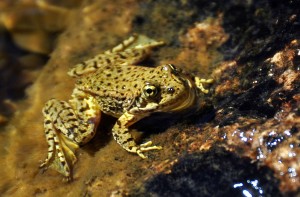
The plan to remove non-native trout from some higher elevation lakes in Sequoia and Kings Canyon National Parks appears to be heading for approval later this year. The goal of the plan, which was designed by local national park staff, is to restore the original aquatic ecosystems and the populations of the original wildlife, including the mountain yellow-legged frog, now considered an endangered species.
The plan calls for the removal of trout from 87 lakes and ponds, or slightly less than 16% of the 549 lakes and ponds in the two local national parks. The process will take more than 30 years, at a cost of $200,000 a year, according to Danny Boiano, aquatic ecologist at Sequoia and Kings Canyon National Parks.
“We finished the public comment period and now we have to analyze it,” Boiano said. “We need to reply to every substantive comment.”
Public meetings in Three Rivers, Fresno and Bishop were held in November, and additional written comments were received up until the December 17 deadline.
“We received comments that were expected,” Boiano said. “We expected a part of the public to support it. We expected a part of the public to be concerned about the use of piscicides (chemical substances poisonous to fish).”
Another concern, which was raised at the public meetings, was about the plan’s effects on fishing in the local parks. Boiano described most of the lakes and ponds in the plan as “really remote” and “historically fishless.”
“Thirty-five years from now, there will still be 462 lakes and ponds with fish,” he said. “We feel the proportion is a balanced approach.”
The local national parks currently have two main types of non-native trout: eastern brook trout, which are not native to western North America; and rainbow trout, which are native to the region but brought into the park.
“Fishing was a big sport,” explained local historian Terry Ommen about why the trout was brought to the area starting in the 1870s. “They never did it for the food.”
“The first planting of fish of any kind done in Tulare County was about 25 years ago, when a planting of white fish and eastern catfish was made in the waters of Tulare Lake,” wrote George W. Stewart, president of the Tulare County Fish and Game League, in an October 11, 1904 letter to the Bureau of Fisheries in Washington, D.C.
“The first planting done in the mountains was by a few persons carrying rainbow trout from the Big and Little Kern and their tributaries, in cans, to the streams and lakes on the western slopes of the mountains,” Stewart continued. “Later, clubs were organized and assisted in the work, and in recent years the state fish commissioners have supplied many thousand small fish for planting in the barren or not well-stocked streams. Among these clubs have been the Visalia Sportsman Club, the Visalia Game Club, the Eshom Valley Fish and Rifle Club, a club at Porterville, and lately the Tulare County Fish and Game League, and the Fish and Game Protective Association, of which there are branches at Visalia, Porterville, Three Rivers and near Kings River.”

“Mules were used to bring fish up into the high country,” said Boiano. “In the 1940s, airplanes were used to drop water and fish into lakes.”
Stewart’s letter, which goes into great detail about when, where and by whom fish were brought into the area, describes the trout as “prolific” – which is part of the problem. Starting in the 1970s, studies showed that the prolific trout was thriving at the expense of the original wildlife, such as birds, snakes, frogs and mammals, which fed by the mountain lakes.
“We stopped stocking (trout) in 1988,” Boiano said. “We started doing fish removal in 2001 because we have to follow the National Environmental Policy Act (NIPA).”
He explained that if any program that uses federal funds to do work is shown to have an effect on the environment, it has to go through the NIPA process to analyze those effects. Non-native trout was affecting the local ecosystems.
An environmental assessment about restoring the endangered mountain yellow frog population to the area was conducted in 2001. The original idea was to use gill nets and electrofishing to remove non-native trout from some park lakes and ponds. It was determined, however, that some of the lakes were too large to effectively remove trout with gill nets or electrofishing. The only other option is piscicide, according to Boiano.
Although the plan is still not formally approved, and the final environmental impact report is still in the works, trout have already been removed from some lakes and ponds on the local parks.
“We’ve been successful in removing fish from 15 lakes,” Boiano said, adding that fish removal is currently being conducted in an additional 11 lakes and ponds. “We’ve shown a huge increase in the native ecosystem. It shows us that it’s worth doing this work.
“Most species came back within one year,” he added. “Some came back in two to three years. That’s what science shows – 70-75% of the species come back in one year and within three years, 95-100% of the native species are back in the ecosystem.”
